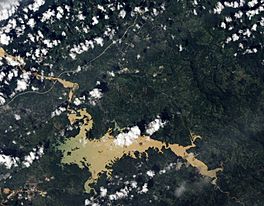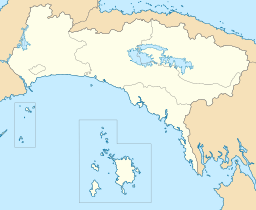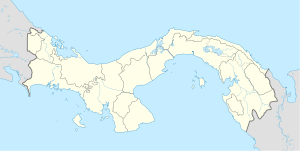Lake Alajuela facts for kids
Quick facts for kids Lake Alajuela |
|
|---|---|

Natural-color satellite image of Lake Alajuela
|
|
| Location | Panamá Province, Panama |
| Coordinates | 9°14′04″N 79°34′32″W / 9.23444°N 79.57556°W |
| Lake type | Reservoir |
| Primary outflows | Panama Canal |
| Catchment area | 1,026 km2 (396 sq mi) |
| Basin countries | Panama |
| Surface area | 50.2 km2 (19.4 sq mi) |
| Water volume | ca. 600 hm3 (2.1×1010 cu ft)) |
| Surface elevation | 76.8 m (252 ft) |
Lake Alajuela (also called Lago Alajuela in Spanish) is a special lake in Panama. It is not a natural lake. Instead, it was created by people in 1935. This lake is very important because it helps the Panama Canal work.
The lake is a reservoir. This means it stores a lot of water. This water is then used for the Panama Canal. The canal is a famous waterway that connects the Atlantic and Pacific Oceans. Lake Alajuela is located southwest of the canal.
Contents
How Lake Alajuela was Formed
Lake Alajuela was made by building a large wall called the Madden Dam. This dam holds back the water of the Chagres River. When the dam was finished, the area behind it filled with water. This created the large lake we see today.
Rivers that Feed the Lake
Many rivers flow into Lake Alajuela. These rivers bring fresh water into the lake. The main river is the Chagres River. Other rivers include the Pequení, Boquerón, and Salamanca.
All these rivers are very important. They provide about 45 percent of all the water needed for the Panama Canal. This shows how vital Lake Alajuela is for the canal's operation.
Name Change of the Lake
For a long time, Lake Alajuela was known by a different name. It used to be called Madden Lake. This was when the Panama Canal Zone was managed by the United States.
Later, control of the Panama Canal was given back to Panama. At that time, the lake's name was changed. It became Lake Alajuela, which is its name today.
Lake Alajuela and the Panama Canal
Lake Alajuela plays a key role in keeping the Panama Canal running smoothly. The canal uses a lot of water to lift and lower ships. This process happens through a system of locks.
The water stored in Lake Alajuela helps to refill these locks. This ensures there is always enough water for ships to pass through. Without this reservoir, the canal would not be able to operate as it does.
High Water Levels in 2010
Sometimes, there can be very heavy rainfall. In early December 2010, Lake Alajuela reached its highest water level ever recorded. This was due to a lot of rain.
Because the water was so high, authorities had to close the Panama Canal. It was closed for 17 hours to ensure safety. The canal was reopened on December 9 after the water levels became safer. This event showed how much the lake's water levels can affect the canal.
See also
 In Spanish: Lago Alajuela para niños
In Spanish: Lago Alajuela para niños



